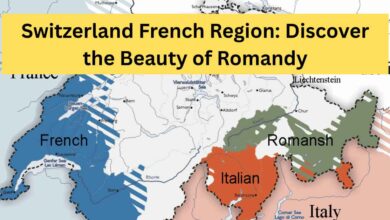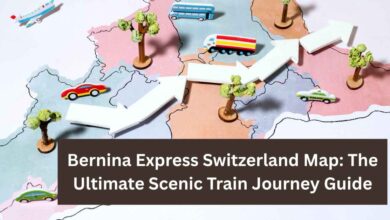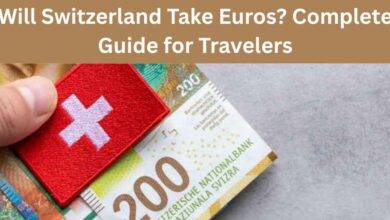Complete Jungfraujoch Travel Guide 2026 – Things to Do

One that crowns the bucket list of most people coming to Switzerland. One that causes your jaw to hit the floor once you’re presented with the astonishing panorama. One that confirms that Switzerland has the potential to make your wallet bleed out. And one that, despite the high costs, is worth every penny to experience.
At Christmas 2016, when I started this blog, my focus was to write about budget-friendly places in Switzerland. I swore to myself that Jungfraujoch wouldn’t make that list.
Ever.
Because Jungfraujoch may be many things but it certainly isn’t budget-friendly.
Almost four years later, at the height of the COVID-19 pandemic, I decided to break my silence. Since borders were closed, tourism had come to an abrupt standstill, and there wasn’t all that much to do, I headed up to Jungfraujoch.
And I was blown away.
Which made me rethink my vow from back in 2016 and reach a new conclusion:
Expensive as it is, Jungfraujoch has earned its rightful spot on every bucket list and every Swiss road trip. And it was about time I stopped excluding this wonderful place from my blog.
So let’s take a look at this special part of the world and try to squeeze it into a budget traveller’s bounds of possibility.
1. What is Jungfraujoch?
Jungfraujoch, also known as the Top of Europe, is Europe’s highest railway station, built for one purpose only:
To attract tourists.
In the late 19th century, Adolf Guyer-Zeller had the ambitious idea to build a cogwheel railway from Kleine Scheidegg through two mountains Eiger and Mönch all the way to Jungfraujoch.
Which, if you think about it, is slightly insane.
The terrain up there is anything but hospitable, and blasting your way through two mountains to end up at 3,454 metres (11,300 feet) above sea level was no small feat.
Especially considering it was the 1890s.
Not surprisingly, the undertaking took its toll, and 30 people lost their lives during construction. Finally, in 1912, this engineering marvel was completed.
Since then, people from around the globe have been visiting Europe’s highest railway station to enjoy the views, breathe the fresh mountain air, and play around in the snow.
Check Also: Best Hikes in Switzerland – Top Trails Maps and Hiking Tips
2. Where is Jungfraujoch?
Dominantly positioned in the Bernese Alps, where the Cantons of Bern and Valais meet, lies Switzerland’s most famous mountain trio: Eiger, Mönch, and Jungfrau. Jungfraujoch is nestled between the peaks of Mönch and Jungfrau.
3. How do I get to Jungfraujoch?
Reaching the Top of Europe is a bit of a mission, to say the least.
First, you need to make your way to Interlaken. That’s not too hard, with frequent trains from Bern, Basel, and the GoldenPass Line from Lucerne. With no more than one or two transfers, you can reach Interlaken from every major Swiss city within a reasonable time.
It’s from Interlaken that things start getting interesting.
The saying “the journey is the destination” is alarmingly accurate in this case.
Here’s how you can reach Jungfraujoch and one crucial detail that might save you a lot of stress:
Make sure you get on the right part of the train in Interlaken. The train splits at Zweilütschinen. Half goes to Lauterbrunnen, the other half to Grindelwald. Read the sign on the train before boarding. If you find yourself on the wrong part, get off in Zweilütschinen and run to the other section.
You probably won’t be the only one doing so.
Option 1: Interlaken – Lauterbrunnen – Wengen – Kleine Scheidegg – Jungfraujoch
Travel from Interlaken to Lauterbrunnen, then transfer to a cogwheel train to Kleine Scheidegg.
Between Lauterbrunnen and Kleine Scheidegg, you’ll pass through Wengen, where the famous Lauberhorn Ski World Cup takes place every January. If you’ve ever wanted to check out the slopes where the pros race down at break-neck speed, this is your chance.
At Kleine Scheidegg, the Jungfraubahn awaits for your final ascent to Jungfraujoch. The one-way trip takes roughly two hours.
Option 2: Interlaken – Grindelwald – Kleine Scheidegg – Jungfraujoch
Another option is via Grindelwald. From Interlaken, travel to Grindelwald, then transfer to the cogwheel railway to Kleine Scheidegg.
This route rewards you with spectacular views of the imposing and deadly north face of the Eiger (Eigernordwand).
Like the first option, the final leg from Kleine Scheidegg to Jungfraujoch is with the Jungfraubahn. Total journey time is about two hours.
Option 3: Interlaken – Grindelwald Terminal – Gondola to Eigergletscher – Jungfraujoch
This third option is the fastest and only possible since December 2020.
From Interlaken, take the train to Grindelwald Terminal (one stop before Grindelwald station). There, transfer to the modern, panoramic Eiger Express gondolas up to Eigergletscher.
At Eigergletscher, hop on the Jungfrau Railway for the final stretch.
This option is 47 minutes faster than the other two routes.
4. What can you expect at Jungfraujoch?
Phew, where to start? I’ll try to keep this short and let the photos speak for themselves.
But in a nutshell, here’s what awaits you at Jungfraujoch:
- Spectacular views of towering mountains and glistening glaciers
- A five-minute photo stop at Eismeer station just before Jungfraujoch
- Insanely steep and slow train rides to Europe’s highest railway station
- Thin air that will leave your heart pounding in your throat
- Plenty of snow to play around in
- Maybe a touch of altitude-induced dizziness
- Several souvenir shops for Swiss Army knives or even Swiss watches
- An ice palace and lots of signs describing Jungfraujoch’s history
- More photo opportunities than you thought possible
- And unless you’re travelling during a global pandemic a crowd of people with the same idea as you
Have fun flipping through the gallery for some impressions of what to expect.
5. How much time should I factor in?
That depends on what you plan to do at the Top of Europe.
If you’re happy just doing the tour through the ice palace, souvenir shops, and viewing platforms, 1.5–2 hours is enough.
Combined with travel time, it’s a solid half-day trip from Interlaken.
But if you’re up for a walk in summer for example, to the Mönchsjoch Hut add another 2–3 hours. And if you’re keen on ziplining, winter sports, or playing in the snow, plan for extra time to visit the Jungfraujoch Snow and Fun Park.
6. How much does it cost to visit Jungfraujoch?
This is where things get tricky.
There are two pages’ worth of ticket options, and prices change seasonally. Your price depends on where you start and end your journey and whether you hold a travel pass.
To give you a rough idea:
If you don’t have any travel pass, expect to pay up to CHF 240 for a round trip from Interlaken to Jungfraujoch, depending on the season.
A travel pass can reduce the cost by 33% to 50%.
7. Where can I buy my Jungfraujoch ticket?
I recommend buying your ticket online it’s super convenient.
If you book through Swiss Activities, you’ll automatically get a seat reservation, which I highly recommend, especially in peak season.
Alternatively, buy your ticket at any staffed Swiss railway station or at the Jungfraubahnen station in Interlaken Ost.
8. How frequently do trains depart?
The timetable changes seasonally. As a general rule, there are two hourly connections from Interlaken, Grindelwald, or Lauterbrunnen to Jungfraujoch.
To plan your trip in detail, check the official online timetable or ask at the Jungfraubahnen station in Interlaken Ost.
9. Are there any ways to save money?
Now we’re getting to the nitty-gritty.
Most things in life leave room for optimization and Jungfraujoch is no exception. Here are three ways to save:
Option 1: Hike part of the way
You can’t hike the whole way to Jungfraujoch, but you can skip the train up to Kleine Scheidegg and hike from either Lauterbrunnen or Grindelwald.
These hikes take around 4–5 hours one way. They’re an excellent way to explore the region, but only attempt them if you’re visiting in summer, physically fit, and experienced in Swiss hiking.
Doing the hike both ways might be a bit much unless you start very early and don’t mind returning late.
Option 2: Get a discount
Buy a travel pass! These passes can significantly reduce your costs:
- Swiss Half Fare Card → 50% discount
- Swiss Travel Pass → 33% discount
- Interrail/Eurail → 33% discount
- Jungfrau Travel Pass → visit Jungfraujoch for CHF 63
My personal recommendation: the Swiss Half Fare Card (CHF 120 for one month). The discount on Jungfraujoch alone almost pays for the card.
Option 3: Rise early
The Good Morning Ticket offers discounts for those who leave before 7 a.m. Check the Jungfrau website for details.
10. What are some cheaper alternatives?
Wondering if there are equally impressive but cheaper destinations? Here are a few spots with similar “wow” factor:
Alternative 1: Aletsch Arena
Instead of the Top of Europe, visit the Aletsch Glacier from the other side in Canton Valais.
Take the gondola from Mörel to Riederalp, hike past Riederfurka and through the Aletsch Forest for spectacular views.
A return gondola trip costs only CHF 20—way better than CHF 210!
Alternative 2: Gornergrat
Zermatt’s Gornergrat is a solid alternative if you want alpine views, thin air, and glaciers.
The cogwheel railway takes you to 3,135 metres (10,280 feet), offering views of the Gorner Glacier and, if the weather cooperates, the Matterhorn.
Round-trip tickets cost CHF 80–126, cheaper than Jungfraujoch. Swiss Travel Pass and Half Fare Card holders get a 50% discount.
Alternative 3: Schilthorn
This iconic peak became famous thanks to the 007 film On Her Majesty’s Secret Service.
At 2,970 metres (9,740 feet), Schilthorn offers magnificent views of Eiger, Mönch, and Jungfrau—and plenty of Bond-themed attractions.
Swiss Travel Pass and Interrail/Eurail passes grant discounts.
Alternative 4: Glacier Express or Bernina Express
Skip Jungfraujoch entirely and ride one of Switzerland’s scenic trains instead.
Both the Glacier Express and Bernina Express offer world-class scenery—and accept all major travel passes.
Without a pass, the Glacier Express costs CHF 152 one way (excluding the mandatory reservation fee). With a travel pass, all you pay is the reservation.
11. Insider Tips
A few random but useful tips from my November 2020 trip:
- Pack a picnic in Interlaken to avoid overpriced food at Jungfraujoch. But if you bring liquids (e.g. yoghurt, cottage cheese), pack them in sealed plastic bags. The pressure difference at 3,500 m can cause lids to burst!
- Wear good shoes and warm clothes. It’s cold up there, even in summer, especially inside the ice palace.
- Bring sunscreen. The sun is intense at high altitude, especially when reflected off the snow.
Is Jungfraujoch worth it?
Expensive? Absolutely. Worth it? 100% yes.
Despite the price tag, Jungfraujoch remains one of Switzerland’s most breathtaking experiences and one that truly belongs on your bucket list.
Frequently Asked Questions:
How long does it take to reach Jungfraujoch?
From Interlaken, it takes about 2 to 2.5 hours one way, depending on connections and routes.
How do I get to Jungfraujoch?
Travel via train from Interlaken, Grindelwald, or Lauterbrunnen. Routes often go through Kleine Scheidegg, where you change trains to the Jungfrau Railway, which tunnels through the Eiger and Mönch mountains.
What is Jungfraujoch?
Jungfraujoch, known as the “Top of Europe,” is a famous mountain saddle in the Swiss Alps at 3,454 meters (11,332 ft). It’s home to Europe’s highest railway station and offers incredible alpine views, ice attractions, and year-round snow.



